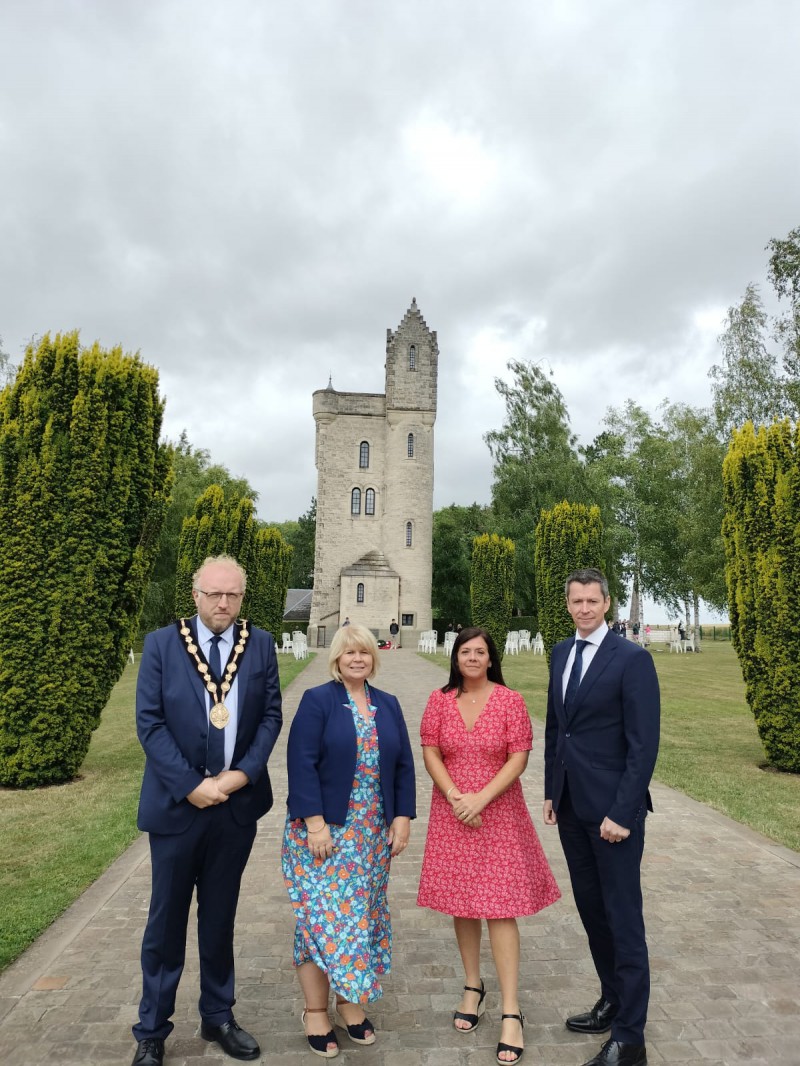The bravery and sacrifice of all those who lost their lives during the Battle of the Somme has been marked by Lisburn & Castlereagh City Council (LCCC).
A group representing the Council travelled to France and Belgium to commemorate what was one of the largest and bloodiest of the First World War (1914-18).
The Mayor of Lisburn & Castlereagh Council, Councillor Andrew Gowan, Councillor Sharon Lowry, and LCCC’s Chief Executive, David Burns travelled to France and Belgium on behalf of Lisburn and Castlereagh, to honour the memory of those who fought in the Battle of the Somme. They participated in memorial services and attended remembrance events, paying their respects to those soldiers who were killed in action.
The visit began at the Regina Trench Cemetery near Thiepval, where the group paid their respects to those soldiers who fought in the battle of the same name in October 1916. Mayor Gowan’s great-grandfather, Richard Elliot (who was born in County Fermanagh), a Corporal in the Canadian Infantry (Quebec Regiment) was one of many brave soldiers who lost his life during this battle, aged just 32.
The following day, the party travelled to Belgium and the Island of Ireland Peace Park at Messines (near Flanders) to remember those from Ireland who died, were wounded or reported missing during WWI.
They also visited Tyne Cot - the largest cemetery for Commonwealth forces in the world, for any war. The cemetery and its surrounding memorial are located outside Passendale, near Zonnebeke in Belgium. There are 12,000 graves here and the names of over 30,000 missing on the memorial panels.
Councillor Sharon Lowry’s great- great-uncle Corporal Edward Barnes, of the 2nd Battalion The Royal Irish Rifles (Ulster Division) is commemorated on the Tyne Cot Memorial Panel. He was killed in action at the Somme in 1918, aged 22, but has no known grave. Corporal Barnes was awarded the Military Medal for bravery in 1917.
The day finished with the laying of a wreath on behalf of the Council at Menin Gate Memorial to the Missing, which remembers British and Commonwealth soldiers whose graves are also unknown. It is one of four British and Commonwealth memorials to the missing in the battlefield area of the Ypres Salient in Belgian Flanders. The memorial bears the names of 54,389 officers and men from United Kingdom and Commonwealth Forces who fell in the Ypres Salient before 16 August 1917 and who have no known grave.
Today (Saturday 1st July), on the 107th anniversary of the beginning of the Battle of the Somme, the Council representatives attended two Somme Association remembrance services and a Royal British Legion service of remembrance at The Thiepval Memorial to the Missing of the Somme. This memorial near the village of Thiepval, Picardy in France commemorates 72,337 missing servicemen who died in the Battles of the Somme between 1915 and 1918, with no known grave.
The group also attended memorial services at the Ulster Tower in Thiepval, and Guillemont. The Ulster Tower is Northern Ireland's National War Memorial, built to commemorate the fallen of 36th Ulster Division and any other Ulstermen who served in the First World War. Guillemont memorial was erected to commemorate the fallen of the 16th Irish Division. The group also visited the Martinsart British Cemetery, where many soldiers are buried, including 10 from Royal Hillsborough.

Tomorrow, the visit will conclude when the group pay their respects at Lochnagar Crater which was created by a large mine placed beneath the German front lines on the first day of the Battle of the Somme, to help the infantry advance. It has been preserved as a memorial site for all of those who have suffered during War and a service is held every 1st of July to mark the start of the Battle of the Somme.
